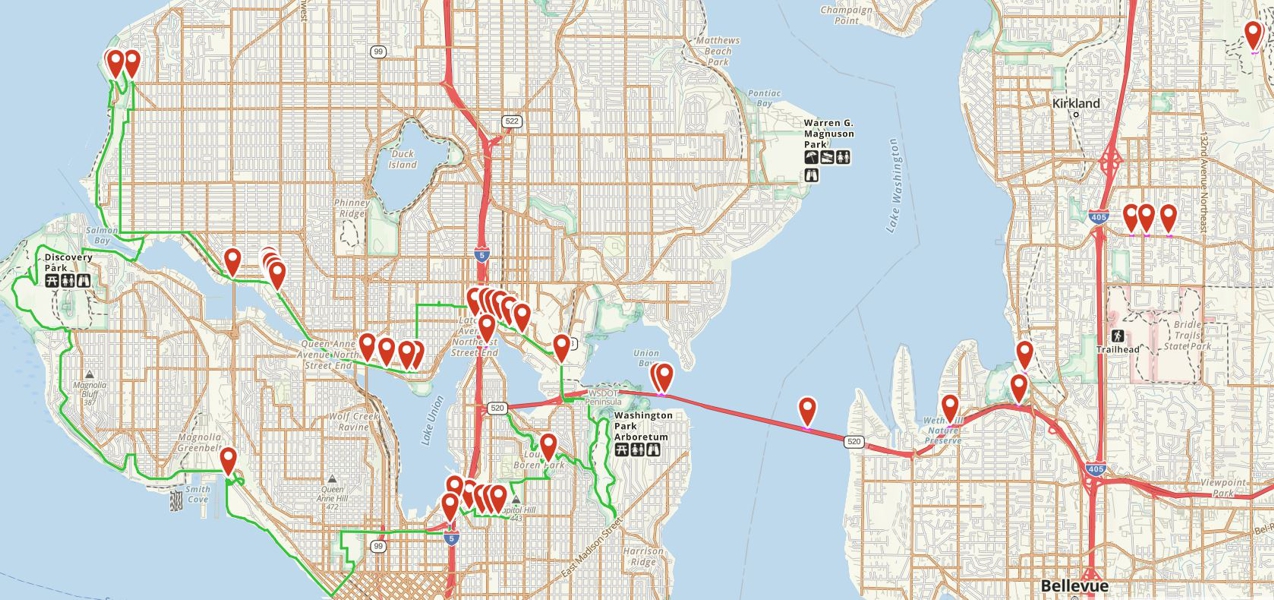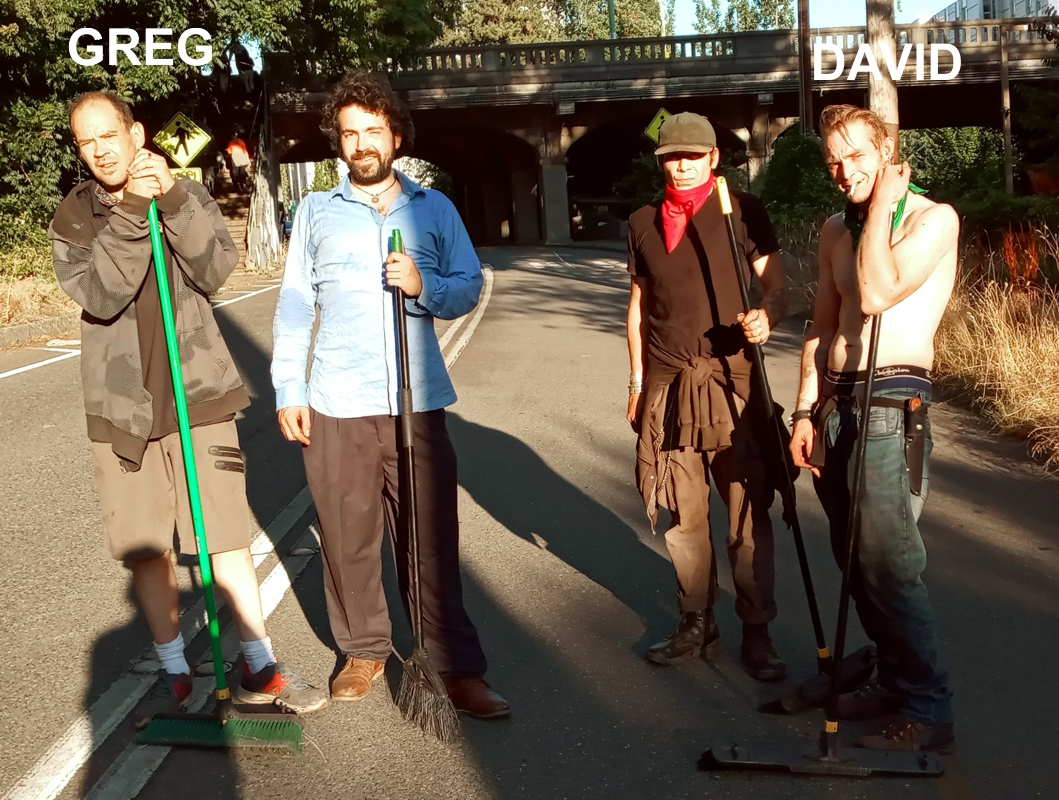Bike in Seattle, Glass and Trash, Bike Lanes, Homelessness, City of Seattle.
I live in Wallingford Seattle Washington and commute by ebike most of the time to
work in Redmond, a fourteen mile ride over the 520 bridge bike lane. I often
take an evening ride on my regular road bike through Seattle to many parks
including water front parks, usually thirty to fifty miles. See green line in map.
While riding these miles I too often see broken glass and or trash. Broken glass
is a problem for bicyclists. Many evenings have been spent riding home to get a
street sweeping broom and related equipment, going back to the site, and sweeping
for sometimes several hours. I have swept up over 65,000 square feet of broken
glass, trash, and lately small rock in bike lanes, trails, and streets.

I donít like this job and it does not pay anything. I would rather be riding my
bicycle like everyone else riding past me while I sweep. Occasionally someone
may say thanks, but it is not the norm. A very few have told me to watch out
for them. I consider this type of comment self-righteous and go on about my
work. Twice other people (not cyclists) have seen me working and just started
helping. This may look like I am doing other riders a favor. It is really more
for me. I donít like to take time to fix a flat.
Sad that Seattle installed all those separated bike lanes. They have no way to
clean these except by manual means, like I do. But this never happens. Often separators
are installed on the best part of the road surface and pushes riders to the worst
parts of road surface. There is no thank you to Seattle from me. Seattle would
rather paint the road than actually fix the road. This is especially a problem
in the fall when there are many trees above many bike lanes. Leaves often hide
the extent of the bike lanes and the underlying glass and trash. Then the leaves
sit and rot all winter causing a muddy buildup of glass and trash.
I have mostly given up on bike lanes and use my ebike for commuting and errands
in the traffic lanes like I have done for so many years before there were
ebikes and bike lanes. I strongly recommend the use of a mirror on glasses when
riding. A mirror is what has kept my alive for 45 years of riding. Trying to
convince other cyclists to use a mirror is difficult. Vehicles have mirrors for
a reason. Why a cyclist riding in traffic would not want to use a mirror for
the same reason is beyond me. This is why there are so many bicycle related
fatalities. Now with ebike I can keep up with traffic fairly well especially
with Vision Zero limiting speed. However I am not seeing too much enforcement
yet possibly due to COVID.
I observed a heavily glassed area on NE40th Street (the part under the University
Bridge) adjacent to a homeless encampment. Not sure if all the glass was caused
by residents of the camp but it definitely got worse after COVID started. Not
going to point fingers. I have swept many parts of the Burk Gilman trail after
a frat party. Being an opportunist I thought I would try a bit of personal
outreach. So I stopped to talk with some residents of the camp and found David
and Greg. I mentioned that I have swept up many places in Seattle and that I
wanted to do some sweeping here. I asked if I could a pay some residents to
help me sweep. But they had no good brooms. I said I would go buy some if some
people would help. They agreed and asked for minimum wage. So I continued my
ride to the hardware store and purchased good street brooms and gloves. Got
home, put the tools and buckets in my van and drove back to the site. There
were two more people that wanted to help. I told the group that we need to do
this systematically to be efficient, and gave them an example. Afte distributing
the equipment it was like herding cats. A very random pattern had developed.
None the less the job was completed in about fifty minutes as opposed to the
three hours it would have taken me alone to do. All were thankful for the cash.

I have been thinking of a scenario of how to employ and incorporate people
experiencing homelessness for a while now. It happened to work out as there was
an encampment adjacent to a problem. When I bought the brooms I thought I would
just donate them to the cause at the camp because this may instill an ongoing
effort to help keep their camp and surroundings a little cleaner.
After we were done I noticed the other side of the road next to the large wall
extremely glassed out and knew this would need sweeping also. Otherwise every
time vehicles did get too close to the wall glass would be spread out
continuing the cycle glass on road way. I have noticed this in many curb side
parking areas that do not get swept by street sweepers. Parked vehicles pull
out of glassed areas spreading glass into traffic. Traffic in turn eventually
throws the glass back to the curb side parking, and the cycle continues.
So I told David and Greg that I would loan them the brooms if they could finish
the job soon, and I would check back in a few days. They agreed, but the sweep
did not happen. I contacted David to arrange a time for an organized sweep with
four people. When I returned for the scheduled time no one was there. David
eventually arrived and he was the only one to help, but he did not know where
the brooms went. I had a smaller broom with me also. So he used the small broom
to sweep an area directly adjacent to the encampment. Hope the other two large
brooms show up.
Not sure if the newly disbanded Seattle Navigation Team ever tried something this.
Not sure if my personal outreach achieved effectiveness or if it was a blip in
time. Not sure if other riders felt as glassed out as I was when I first saw
the mess, or if they cared at all. I have tried to get interest in this concept
from the City of Seattle. It fell on deaf ears. They felt that trying to
organize a multidepartment effort was too difficult. Just shows the dichotomy
of institution not able to be effective or efficient and a labor pool that
would love to have some work. Especially in this time of COVID where hand outs
are not as available.
Not implying that I have all the answers to the homeless situation. Homelessness is
a multipronged problem. Some homeless people have given up on institution, or
actually fear it. Many do have substance abuse problems, possibly caused by
fears of institution and other internal fears. Some arrived at homelessness
from societal rejection, like veterans who experienced trauma and have internal
visions society does not recognize or want to deal with. The term homelessness
is too encompassing. There are too many ways people arrive at homelessness to
be lumped together as a single problem. Homeless people need to be recognized
on an individual basis and be truly understood before the larger problem can be
addressed. We have to start somewhere.